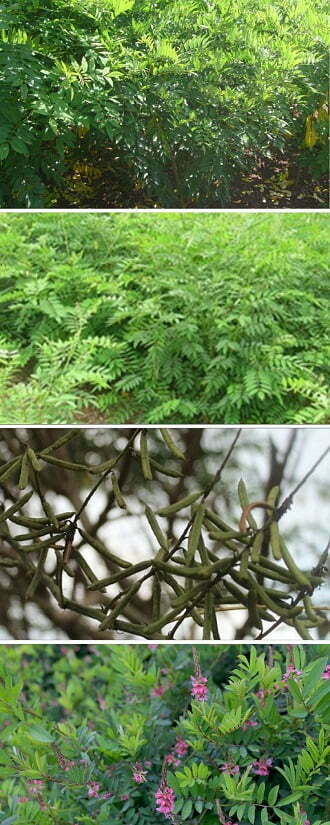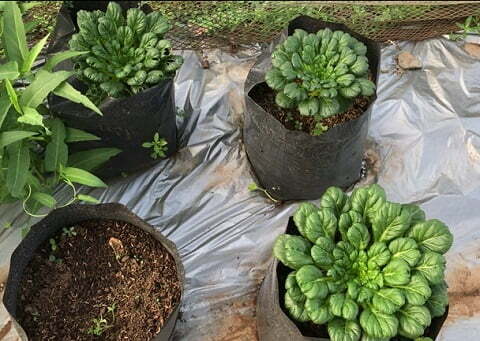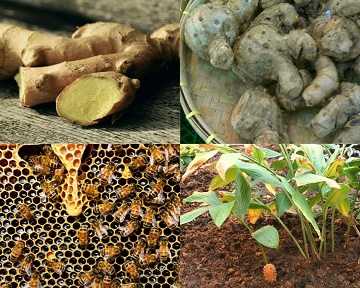What is the Indigofera tinctoria plant?
Indigofera tinctoria is one of the important plants in human life. This plant is classified as a type of leguminous plants or legumes. This is because the fruits of Indigofera plants are pods.
like this.
In the field of animal feed, this plant is included in the type of legume plant. As a good source of protein for livestock. Later, we will discuss the details of this.
Indigofera sp. Having very many types. Some say about 700. But, the most easily found types are Indigofera spicata, Indigofera stragalina, Indigofera tinctoria, Indigofera natalensis, Indigofera arrecta, Indigofera zollingeriana and Indigofera australis.
Characteristics of Indigofera plants
Although there are many types, these Indigofera can be physically identified with the following characteristics:
Plants grow upright, have many branches and roots can grow deep enough to the ground.
Bright green leaves and purple flowers.
The height can be up to 2 meters with a diameter of 20 cm. Large enough for the size of a legume plant.
Examples of Indigofera plants can be seen in the image below.
While the types of Indigofera plants are very large in number. There are 750 names for this Indigofera. If you intend to know all of it, please look at the link that I have embedded.
The use of indigofera plants
With that many types, and has spread in various regions of the world, certainly many benefits can be taken from this plant.
The main use of this plant is as a coloring agent and as an herbal plant.
Now, in Indonesia Indigofera has a new benefit as livestock feed. Indigofera is now widely cultivated because of its good quality to become a feed.
Indigofera for fabric dyes
Not all indigofera plants can be used as coloring agents. Only a few can be used.
The types commonly used for this dye are indigofera tinctoria and indigofera suffruticosa. The resulting color is indigo colors for sure.
Indigofera for medicine and health
In the herbal field, indigofera can be used for the following things:
- Toothache can be treated with indigofera articulata.
- Reducing swelling due to insect stings and snakebites can be treated with indigofera oblongifolia.
- Gastric ulcer disease can be treated using arrecta indigofera.
- Parts of Indigofera brevicalyx and Indigofera swaziensis can be used to brush teeth.
Indigofera plants for livestocks feed
As with other legume plants, indigofera is very good for livestocks feed.
This is the advantage of indigofera when compared with other forage plants.
- Tolerant with minimal water area. Thus, indigofera cultivation is very suitable to be an alternative feed during the dry season.
- The productivity of forage is quite high.
- Contains high protein so it is good for fattening cattle and dairy cattle / goats.
- It has a high digestibility value so that more nutrients are absorbed by livestock than are wasted with manure.
- The mineral content is ideal for livestock needs. It can help livestock growth more optimally.
- Antinutrient indigofera is very low, especially tannins. The tannin content is only 0.6 – 1.4 ppm.
- Palatability is high or preferred by livestock.
Indigofera tinctoria for goats
As a legume plant, indigofera tinctoria functions more as a source of protein for goats.
Protein is needed especially for goats that are in high production.
For example, goats that are in its infancy or currently in their lactation period.
With more indigofera portions in the ration, livestock growth, daily weight gain and milk production can be maximized.
However, it is not recommended to use indigofera as a single feed. Still have to add other types of feed in its administration, such as grass.
We will see how well these indigofera leaves can increase goat production. Whether it’s from growth, weight gain and milk production.
That way we can have a view of the potential for a feed so that livestock becomes more efficient.
Goat in the age of growth
The best composition of indigofera plants for goat growing age is 50% grass and 50% indigofera. [3]
The composition of the ration can produce a daily weight gain of an average of 44 grams/head / day. When compared to goats that are only given full grass, the weight gain/day is only 37 grams/head / day.
There is a difference of about 7 grams per day/head. In other words, indigofera can increase daily weight gain about 18% higher than goats with grass feed alone.
Feed is given as much as 4 % dry matter of the weight of the goat. If the weight of the goat is 11 kg, then the amount of feed given is 440 grams in dry matter. Means, 220 grams for indigofera and 220 grams for grass.
If given fresh, we need to look at the dry weight data of each feed.
The dry weight of indigofera is 22% and field grass is 18%. So, in the fresh form, indigofera and grass given are about 1 kg and 1.2 kg, respectively.
From other studies, it turns out the results obtained are better.
Goats by giving 45% indigofera in the ration gave an average daily weight increase of 52 grams/head/day. [4] Whereas goats with only grass feed, weight gain/day is only 28 grams/head/day.
There was an increase in daily gain of 85% more. Isn’t this amazing?
Why are the results so different from the first research?
Many factors can influence.
First is the genetic quality of the goats. But, because the type of goat used is the same, namely boerka (Boer x local goat), then the cause of the difference in these results may be due to other factors.
Second is the age and indigofera cutting technique. The older the harvest, the indigofera nutrient content will decrease, crude fiber increases and digestibility is lower.
The younger the age of cutting, the better nutritional content but less forage production is obtained.
Indigofera is a concentrate replacer
Feed from dairy goats usually always use concentrate. This concentrate can boost milk production due to its excellent nutritional content.
In general, the composition of rations for dairy goats is 60% grass and 40% is concentrate.
What if 40% of this concentrate is replaced with indigofera?
If the price of concentrate is indeed considered expensive, the alternative can be to use indigofera leaves.
If we see, the nutrient content of these indigofera is higher than the concentrate. Especially for crude protein content. Please compare yourself.
So, indirectly the feed from indigofera can also be considered as a substitute for concentrate.
We will see evidence that feed from indigofera can give the same results from concentrated feed, even better.
Saanen goats with indigofera rations can produce milk on average 660 ml/head/day. When compared to the results of the concentrate ration which is only 539 ml/head/day. While the goat PE (jamnapari cross), milk production from indigofera ration is 762 ml/head/day and the average concentrate feed is only 379 ml/head/day. [5]
This data is taken in lactation conditions outside the peak production, indigofera is given in the form of pellets and ration is given as much as 4% dry matter of the bodyweight of the goat.
In the form of pellets, indigofera nutritional content is different from those of fresh forage conditions. Especially the value of dry matter.
The dry matter of this indigofera pellet is much higher. A comparison of nutritional content can be seen in the table below.
Nutritional content | Indigofera pellet | Indigofera forage |
Dry Matter (%) | 88,11 | 21,97 |
Ash (%) | 6,41 | 6,14 |
Crude Protein (%) | 25,66 | 24,17 |
Crude Fiber (%) | 14 | 15,25 |
Fat (%) | 2,9 | 6,15 |
Beta N (%) | 39,14 | |
TDN (%) | 75,47 |
Dry material in pellets is higher because before being made pellets, indigofera leaves are dried first so that the water content is reduced.
The amount of dry material from these pellets is almost 4 times that of indigofera while still in the form of forage.
So, just as it is difficult to get the pellets, the amount of forage that we provide must be 4 times more.
Indigofera plants for cattle
If the effects of indigofera plants for goats are that good, the same is true for cattle.
Mostly, the forages given to cattle are elephant grass and king grass. This grass is very easy to cultivate and has pretty nutritional content.
Actually, with simple maintenance, cows with these feeds, can already grow well. This is in the article on elephant grass for cattle feed.
However, cattle with rations contain indigofera, their daily weight gain is higher.
According to research, 60% of indigofera in rations can increase the daily weight gain of beef cattle 39% higher. [6]
In that study, the ration used was full forage, elephant grass.
Then, some elephant grass is replaced with indigofera. Until the maximum number of indigofera in the ration is as much as 60%.
So, with 40% feed on elephant grass and 60% forage indigofera, the daily weight gain of cows is around 0.5 kg/head/day.
Why only 0.5 kg? This depends on the type or breed of beef cattle.
As for PO (Ongole cross breed) cattle, this increase is already quite good. But for imported beef classes such as Simmental and limousine, this increase is quite small.
If you are interested in using feed rations like this, the technique is quite easy.
How to calculate the ration is the same as the goat above. We have to know the weight of the cow, the dry weight of elephant grass and indigofera, then we can calculate the estimated amount that must be given in fresh form.
Indigofera plants for laying hens
We know that forages from indigofera are of high quality. For ruminants such as goats, sheep, and cattle, there is no problem.
But for poultry, the story might be a little different. Which becomes different because of this crude fiber from indigofera.
Crude fiber as much as 15% is quite small for ruminants. But, that is a large amount for poultry.
Poultry need crude fiber far smaller than that. This is because birds have a monogastric digestive tract.
Therefore, the use of indigofera plants for poultry needs to be limited.
At present, there have not been many studies on indigofera leaves for poultry.
However, one of the literature states that for a mixture of laying hens, indigofera can be given as much as 5-15%. [7]
This amount is the optimal number so that production from laying hens is not interrupted.
Indigofera cultivation
We must try to cultivate this indigofera plant. Because to be able to get the benefits of this quality forage, the only easiest way is to plant it yourself.
This plant can be planted from seed or stem cuttings. But, if there are no plants, then what will be cuttings? Like it or not, at the beginning you have to buy the seeds.
But before that, there are two things that must be determined for this indigofera cultivation.
First, the type of indigofera and second is the land and location of planting.
Not all types of indigofera are easy to obtain. Currently, what is being developed for animal feed is zollingeriana indigofera.
The advantages of indigofera plants as forage feed
There are many types of legumes whose quality is also as good as indigofera. For example, River tamarind, Calliandra, and Vegetable hummingbird are also good sources of protein for goats or cows.
So, why have indigofera? This is the reason why indigofera is superior.
1. Indigofera has better nutritional quality. Not only is the crude protein value, but the fiber and antinutrients are also small.
2. Tolerant with poor soil types. Indigofera can grow quite well inland where conditions are lacking water, alkaline soil, and acid soil.
3. Higher growth and forage production. Indigofera can produce fresh forages as much as 33 tons/ha/year while Gliricidia sepium is only 28 tons/ha/year. [8]
Indigofera cultivation techniques
1 Seeding.
Indigofera seeds soaked with water overnight. After that, it is germinated and sown. It can be sown in a tray.
After 10 days of seedling, plants can be moved to 0.5 kg polybags.
The time needed for seeding is between 30 – 41 days.
Young seedlings are kept under shade by using 65 % shade paranet.
If planting from stem cuttings, select stems that have good growth. Cut 30 cm in length.
Do not immediately planted but allowed to stand for 1-3 days. The planted tip is placed on top.
2 Tillage
For better results, it is necessary to fertilize the land. Unless you want modest results, land management can be done at will.
The dosage of fertilizer when using compost is 5 tons/hectare. If the land area is only 1000 square meters, the manure will need 0.5 tons/hectare.
Without dosage, give manure per planting hole between 250 – 300 grams.
3 Planting
Spacing needs to be adjusted. Monoculture planting system (special land planted with Indigofera), the spacing can be arranged 1-meter x 1.5 meters.
If you want to plant it intercropping, it means that the distance is widened at least 3 meters x 3 meters. So that the main plant is not covered to get sunlight.
4 Care
For treatment only weed weeds, watering and foliar fertilization (spray leaf fertilizer), if you want. Not sprayed is also not a problem.
If you wish, planting can use mulch plastic. This can suppress the emergence of weeds and can reduce surface water to evaporate.
5 Harvesting
The first harvest can be done 60 days after planting. By pruning.
The point of trimming is at least 1 meter from the ground.
Subsequent harvesting is done every 60 days after pruning.
Indigofera forage processing
If the land owned is large enough, then the forage yields every time the harvest will be abundant. To be stored for a long time, this crop needs to be processed.
The simplest processing is to make Indigofera leaf flour.
Because the steps are quite simple and the tools needed are also not too expensive. The most expensive is probably only the grinding machine.
The best step to make indigofera flour is in this article. Please read.
I think that’s enough for this Indigofera plant, hopefully, it’s useful. Please SHARE Bro, let others know too.
Reference
[1] https://en.wikipedia.org/wiki/Indigofera
[2] http://www.litbang.pertanian.go.id/info-teknologi/1704/
[3] Simanihuruk, K. And J. Sirait. Utilization of Indigofera sp. Legume tree. As Boerka Goat Basal Feed Growth Phase. North Sumatra Goat Cut Research Station. National Seminar on Animal Husbandry and Veterinary Technology 2009.
[4] Tarigan, Andi and S. P. Ginting. Effect of the level of administration of Indigofera sp. Against Feed Consumption and Digestion and Increase in Life Weight of Goats Given Brachiaria ruziziensis Grass. North Sumatra Goat Cut Research Station. JITV Vol. 16 No1 Th. 2011: 25-32.
[5] Titis Anugraheni P. A. 2011. Utilization of Indigofera sp. Pellet. In the Etawah and Saanen Peranakan Dairy Sheep at Bangun Karso Farm Farm. Department of Nutrition and Feed Technology, Faculty of Animal Husbandry, Bogor Agricultural University.
[6] Nurhayu, A. and Daniel Pasambe. Indigofera as Forage Substitution in Beef Cattle Feed in Bulukumba Regency, South Sulawesi. South Sulawesi Agricultural Technology Assessment Office. National Seminar on Animal Husbandry 2, Faculty of Animal Science, Hasanuddin University Makassar, August 25, 2016.
[7] Wahyuni Lubis, Sri. 2018. The Effect of Indigofera zollingeriana Leaf Flour Use in the Ration on Ration Consumption, Protein Consumption, Hen-day and the weight of Broiler Eggs. Thesis. Department of Animal Husbandry, University of Lampung.
[8] Herdiawan, Iwan and Krisnan R. Productivity and Utilization of Indigofera zollingeriana Tree Legume Plants on Dry Land. Bogor Animal Research Institute. WARTAZOA Vol. 24 No. 2 years. 2014 p. 75-82.
 JOYNIM FARM Goat Farming, Cattle Farm, Laying Hens, Quail Farm, Gardening
JOYNIM FARM Goat Farming, Cattle Farm, Laying Hens, Quail Farm, Gardening






